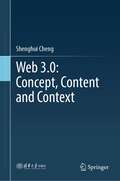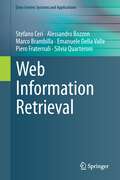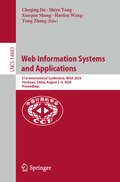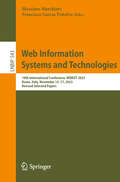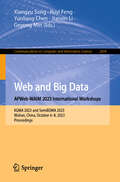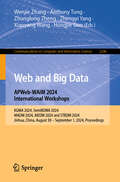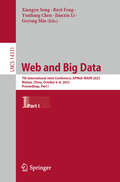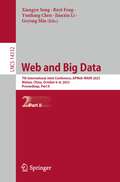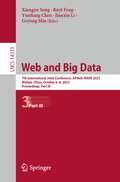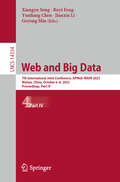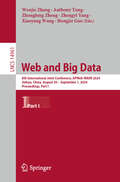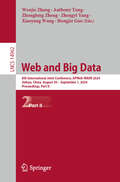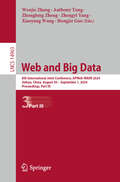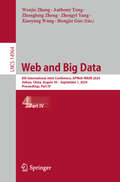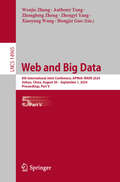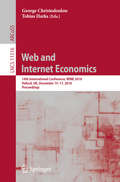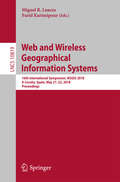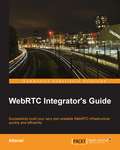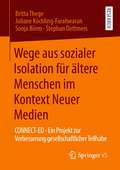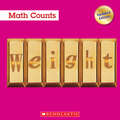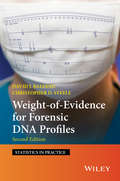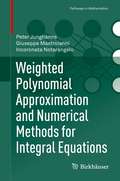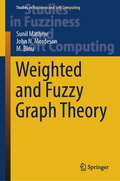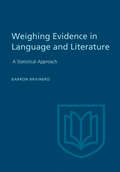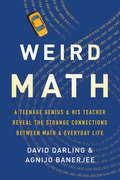- Table View
- List View
Web 3.0: Concept, Content and Context
by Shenghui ChengAs technology continues to advance, the Internet is evolving into what is often referred to as Web 3.0. This book aims to achieve three main objectives, first, it introduces Web 3.0 systematically and comprehensively, providing readers with a foundational understanding of its concepts and characteristics. Second, it analyzes the inevitability and development necessity of Web 3.0, as well as its potential future possibilities and transformative effects. Finally, it explores Web 3.0 through comparative analysis, discussing its relationship with the metaverse as well as how individuals and organizations can seize the opportunities presented by Web 3.0. Various topics related to Web 3.0, including its infrastructure, development facilities, scenario applications, technology stacks, and industry applications such as decentralized applications (DApps) and Software-as-a-Service (SaaS) platforms are presented in the book. It delves into the ecosystem of Web 3.0, discussing decentralized autonomous organizations (DAOs), open finance (DeFi), cryptocurrencies, token economy, digital identity, creator economy, attention economy, and cyber-physical and human systems. Additionally, it addresses governance issues, security challenges, development challenges, and legal and regulatory aspects associated with Web 3.0. Overall, Web 3.0: Concept, Content and Context provides readers with a comprehensive understanding of Web 3.0, its potential implications, and the opportunities for new industry models and business opportunities in the evolving Internet era.
Web Information Retrieval
by Emanuele Della Valle Marco Brambilla Piero Fraternali Alessandro Bozzon Stefano Ceri Silvia QuarteroniWith the proliferation of huge amounts of (heterogeneous) data on the Web, the importance of information retrieval (IR) has grown considerably over the last few years. Big players in the computer industry, such as Google, Microsoft and Yahoo!, are the primary contributors of technology for fast access to Web-based information; and searching capabilities are now integrated into most information systems, ranging from business management software and customer relationship systems to social networks and mobile phone applications. Ceri and his co-authors aim at taking their readers from the foundations of modern information retrieval to the most advanced challenges of Web IR. To this end, their book is divided into three parts. The first part addresses the principles of IR and provides a systematic and compact description of basic information retrieval techniques (including binary, vector space and probabilistic models as well as natural language search processing) before focusing on its application to the Web. Part two addresses the foundational aspects of Web IR by discussing the general architecture of search engines (with a focus on the crawling and indexing processes), describing link analysis methods (specifically Page Rank and HITS), addressing recommendation and diversification, and finally presenting advertising in search (the main source of revenues for search engines). The third and final part describes advanced aspects of Web search, each chapter providing a self-contained, up-to-date survey on current Web research directions. Topics in this part include meta-search and multi-domain search, semantic search, search in the context of multimedia data, and crowd search. The book is ideally suited to courses on information retrieval, as it covers all Web-independent foundational aspects. Its presentation is self-contained and does not require prior background knowledge. It can also be used in the context of classic courses on data management, allowing the instructor to cover both structured and unstructured data in various formats. Its classroom use is facilitated by a set of slides, which can be downloaded from www.search-computing.org.
Web Information Systems and Applications: 21st International Conference, WISA 2024, Yinchuan, China, August 2–4, 2024, Proceedings (Lecture Notes in Computer Science #14883)
by Shiyu Yang Haofen Wang Yong Zhang Cheqing Jin Xuequn ShangThis book constitutes the refereed proceedings of the 21st International Conference on Web Information Systems and Applications, WISA 2024, held in Yinchuan, China, during August 2–4, 2024. The 39 full papers and 11 short papers presented in this book were carefully selected and reviewed from 193 submissions. These papers have been organized in the following topical sections: Knowledge construction; Intelligent service; Intelligent computing; Large language model; Security; Information system applications.
Web Information Systems and Technologies: 19th International Conference, WEBIST 2023, Rome, Italy, November 15–17, 2023, Revised Selected Papers (Lecture Notes in Business Information Processing #543)
by Massimo Marchiori Francisco García PeñalvoThis book constitutes the refereed proceedings of the 19th International Conference on Web Information Systems and Technologies, WEBIST 2023, held in Rome, Italy, during November 15–17, 2023. The 5 full papers and 8 short papers included in this book were carefully reviewed and selected from 77 submissions. The selected papers contribute to the understanding of relevant trends of current research on Web Information Systems and Technologies, including: Human Computer Interaction, Application, Research Project and Internet Technology, UX and User-Centric Systems, Web Programming, Web Tools and Languages, Applications, Research Projects and Web Intelligence, Natural Language Processing, Human Factors, Web Information Filtering and Retrieval and Web Interfaces and Applications.
Web and Big Data. APWeb-WAIM 2023 International Workshops: KGMA 2023 and SemiBDMA 2023, Wuhan, China, October 6–8, 2023, Proceedings (Communications in Computer and Information Science #2094)
by Jianxin Li Geyong Min Xiangyu Song Ruyi Feng Yunliang ChenThis proceedings constitutes selected papers from the Workshops KGMA and SemiBDMA which were held in conjunction with APWeb-WAIM 2023 which took place in Wuhan, China, during October 6-8, 2023. The 7 full papers included in this book were carefully reviewed and selected from 15 papers submitted to these workshops. They focus on new research approaches on the theory, design, and implementation of data management systems.
Web and Big Data. APWeb-WAIM 2024 International Workshops: KGMA 2024, SemiBDMA 2024, MADM 2024, AIEDM 2024 and STBDM 2024, Jinhua, China, August 30 - September 1,2024, Proceedings. (Communications in Computer and Information Science #2246)
by Wenjie Zhang Xiaoyang Wang Zhengyi Yang Anthony Tung Zhonglong Zheng Hongjie GuoThis proceedings constitutes selected papers from the Workshops KGMA, SemiBDMA, MADM, AIEDM and STBDM which were held in conjunction with APWeb-WAIM 2024 which took place in Jinhua, China, August 30–September 1, 2024. The 28 full papers presented were carefully reviewed and selected from 49 submissions. the five workshops accepted a total of 28 papers, marking an acceptance rate of 57.14%. Each submission has been peer-reviewed by 3-4 reviewers. The five workshops were as follows: 1. The 7th International Workshop on Knowledge Graph Management and Applications (KGMA 2024). 2. The 6th International Workshop on Semi-structured Big Data Management and Applications (SemiBDMA 2024). 3. The 1st International Workshop on Mobile Applications and Data Management (MADM 2024). 4. The 1st International Workshop on Artificial Intelligence in Education and Educational Data Mining (AIEDM 2024). 5. The 1st International Workshop on Spatio-Temporal Big Data Management (STBDM 2024).
Web and Big Data: 7th International Joint Conference, APWeb-WAIM 2023, Wuhan, China, October 6–8, 2023, Proceedings, Part I (Lecture Notes in Computer Science #14331)
by Jianxin Li Geyong Min Xiangyu Song Ruyi Feng Yunliang ChenThe 4-volume set LNCS 14331, 14332, 14333, and 14334 constitutes the refereed proceedings of the 7th International Joint Conference, APWeb-WAIM 2023, which took place in Wuhan, China, in October 2023. The total of 138 papers included in the proceedings were carefully reviewed and selected from 434 submissions. They focus on innovative ideas, original research findings, case study results, and experienced insights in the areas of the World Wide Web and big data, covering Web technologies, database systems, information management, software engineering, knowledge graph, recommend system and big data.
Web and Big Data: 7th International Joint Conference, APWeb-WAIM 2023, Wuhan, China, October 6–8, 2023, Proceedings, Part II (Lecture Notes in Computer Science #14332)
by Jianxin Li Geyong Min Xiangyu Song Ruyi Feng Yunliang ChenThe 4-volume set LNCS 14331, 14332, 14333, and 14334 constitutes the refereed proceedings of the 7th International Joint Conference, APWeb-WAIM 2023, which took place in Wuhan, China, in October 2023. The total of 138 papers included in the proceedings were carefully reviewed and selected from 434 submissions. They focus on innovative ideas, original research findings, case study results, and experienced insights in the areas of the World Wide Web and big data, covering Web technologies, database systems, information management, software engineering, knowledge graph, recommend system and big data.
Web and Big Data: 7th International Joint Conference, APWeb-WAIM 2023, Wuhan, China, October 6–8, 2023, Proceedings, Part III (Lecture Notes in Computer Science #14333)
by Jianxin Li Geyong Min Xiangyu Song Ruyi Feng Yunliang ChenThe 4-volume set LNCS 14331, 14332, 14333, and 14334 constitutes the refereed proceedings of the 7th International Joint Conference, APWeb-WAIM 2023, which took place in Wuhan, China, in October 2023. The total of 138 papers included in the proceedings were carefully reviewed and selected from 434 submissions. They focus on innovative ideas, original research findings, case study results, and experienced insights in the areas of the World Wide Web and big data, covering Web technologies, database systems, information management, software engineering, knowledge graph, recommend system and big data.
Web and Big Data: 7th International Joint Conference, APWeb-WAIM 2023, Wuhan, China, October 6–8, 2023, Proceedings, Part IV (Lecture Notes in Computer Science #14334)
by Jianxin Li Geyong Min Xiangyu Song Ruyi Feng Yunliang ChenThe 4-volume set LNCS 14331, 14332, 14333, and 14334 constitutes the refereed proceedings of the 7th International Joint Conference, APWeb-WAIM 2023, which took place in Wuhan, China, in October 2023. The total of 138 papers included in the proceedings were carefully reviewed and selected from 434 submissions. They focus on innovative ideas, original research findings, case study results, and experienced insights in the areas of the World Wide Web and big data, covering Web technologies, database systems, information management, software engineering, knowledge graph, recommend system and big data.
Web and Big Data: 8th International Joint Conference, APWeb-WAIM 2024, Jinhua, China, August 30 – September 1, 2024, Proceedings, Part I (Lecture Notes in Computer Science #14961)
by Wenjie Zhang Xiaoyang Wang Zhengyi Yang Anthony Tung Zhonglong Zheng Hongjie GuoThe five-volume set LNCS 14961, 14962, 14963, 14964 and 14965 constitutes the refereed proceedings of the 8th International Joint Conference on Web and Big Data, APWeb-WAIM 2024, held in Jinhua, China, during August 30–September 1, 2024. The 171 full papers presented in these proceedings were carefully reviewed and selected from 558 submissions. The papers are organized in the following topical sections: Part I: Natural language processing, Generative AI and LLM, Computer Vision and Recommender System. Part II: Recommender System, Knowledge Graph and Spatial and Temporal Data. Part III: Spatial and Temporal Data, Graph Neural Network, Graph Mining and Database System and Query Optimization. Part IV: Database System and Query Optimization, Federated and Privacy-Preserving Learning, Network, Blockchain and Edge computing, Anomaly Detection and Security Part V: Anomaly Detection and Security, Information Retrieval, Machine Learning, Demonstration Paper and Industry Paper.
Web and Big Data: 8th International Joint Conference, APWeb-WAIM 2024, Jinhua, China, August 30 – September 1, 2024, Proceedings, Part II (Lecture Notes in Computer Science #14962)
by Wenjie Zhang Xiaoyang Wang Zhengyi Yang Anthony Tung Zhonglong Zheng Hongjie GuoThe five-volume set LNCS 14961, 14962, 14963, 14964 and 14965 constitutes the refereed proceedings of the 8th International Joint Conference on Web and Big Data, APWeb-WAIM 2024, held in Jinhua, China, during August 30–September 1, 2024. The 171 full papers presented in these proceedings were carefully reviewed and selected from 558 submissions. The papers are organized in the following topical sections: Part I: Natural language processing, Generative AI and LLM, Computer Vision and Recommender System. Part II: Recommender System, Knowledge Graph and Spatial and Temporal Data. Part III: Spatial and Temporal Data, Graph Neural Network, Graph Mining and Database System and Query Optimization. Part IV: Database System and Query Optimization, Federated and Privacy-Preserving Learning, Network, Blockchain and Edge computing, Anomaly Detection and Security Part V: Anomaly Detection and Security, Information Retrieval, Machine Learning, Demonstration Paper and Industry Paper.
Web and Big Data: 8th International Joint Conference, APWeb-WAIM 2024, Jinhua, China, August 30 – September 1, 2024, Proceedings, Part III (Lecture Notes in Computer Science #14963)
by Wenjie Zhang Xiaoyang Wang Zhengyi Yang Anthony Tung Zhonglong Zheng Hongjie GuoThe five-volume set LNCS 14961, 14962, 14963, 14964 and 14965 constitutes the refereed proceedings of the 8th International Joint Conference on Web and Big Data, APWeb-WAIM 2024, held in Jinhua, China, during August 30–September 1, 2024. The 171 full papers presented in these proceedings were carefully reviewed and selected from 558 submissions. The papers are organized in the following topical sections: Part I: Natural language processing, Generative AI and LLM, Computer Vision and Recommender System. Part II: Recommender System, Knowledge Graph and Spatial and Temporal Data. Part III: Spatial and Temporal Data, Graph Neural Network, Graph Mining and Database System and Query Optimization. Part IV: Database System and Query Optimization, Federated and Privacy-Preserving Learning, Network, Blockchain and Edge computing, Anomaly Detection and Security Part V: Anomaly Detection and Security, Information Retrieval, Machine Learning, Demonstration Paper and Industry Paper.
Web and Big Data: 8th International Joint Conference, APWeb-WAIM 2024, Jinhua, China, August 30 – September 1, 2024, Proceedings, Part IV (Lecture Notes in Computer Science #14964)
by Wenjie Zhang Xiaoyang Wang Zhengyi Yang Anthony Tung Zhonglong Zheng Hongjie GuoThe five-volume set LNCS 14961, 14962, 14963, 14964 and 14965 constitutes the refereed conference proceedings of the 8th International Joint Conference on Web and Big Data, APWeb-WAIM 2024, held in Jinhua, China, during August 30–September 1, 2024. The 171 full papers presented in these proceedings were carefully reviewed and selected from 558 submissions. The papers are organized in the following topical sections: Volume I: Natural language processing, Generative AI and LLM, Computer Vision and Recommender System. Volume II: Recommender System, Knowledge Graph and Spatial and Temporal Data. Volume III: Spatial and Temporal Data, Graph Neural Network, Graph Mining and Database System and Query Optimization. Volume IV: Database System and Query Optimization, Federated and Privacy-Preserving Learning, Network, Blockchain and Edge computing, Anomaly Detection and Security Volume V: Anomaly Detection and Security, Information Retrieval, Machine Learning, Demonstration Paper and Industry Paper.
Web and Big Data: 8th International Joint Conference, APWeb-WAIM 2024, Jinhua, China, August 30 – September 1, 2024, Proceedings, Part V (Lecture Notes in Computer Science #14965)
by Wenjie Zhang Xiaoyang Wang Zhengyi Yang Anthony Tung Zhonglong Zheng Hongjie GuoThe five-volume set LNCS 14961, 14962, 14963, 14964 and 14965 constitutes the refereed proceedings of the 8th International Joint Conference on Web and Big Data, APWeb-WAIM 2024, held in Jinhua, China, during August 30–September 1, 2024. The 171 full papers presented in these proceedings were carefully reviewed and selected from 558 submissions. The papers are organized in the following topical sections: Part I: Natural language processing, Generative AI and LLM, Computer Vision and Recommender System. Part II: Recommender System, Knowledge Graph and Spatial and Temporal Data. Part III: Spatial and Temporal Data, Graph Neural Network, Graph Mining and Database System and Query Optimization. Part IV: Database System and Query Optimization, Federated and Privacy-Preserving Learning, Network, Blockchain and Edge computing, Anomaly Detection and Security Part V: Anomaly Detection and Security, Information Retrieval, Machine Learning, Demonstration Paper and Industry Paper.
Web and Internet Economics: 14th International Conference, WINE 2018, Oxford, UK, December 15–17, 2018, Proceedings (Lecture Notes in Computer Science #11316)
by George Christodoulou Tobias HarksThis book constitutes the thoroughly refereed proceedings of the 14th International Conference on Web and Internet Economics, WINE 2018, held in Oxford, UK, in December 2018. The 28 full papers presented were carefully reviewed and selected from 119 submissions. The papers reflect the work of researchers in theoretical computer science, artificial intelligence, and microeconomics who have joined forces to tackle problems at the intersection of computation, game theory and economics.
Web and Wireless Geographical Information Systems: 16th International Symposium, W2GIS 2018, A Coruña, Spain, May 21–22, 2018, Proceedings (Lecture Notes in Computer Science #10819)
by Miguel R. Luaces Farid KarimipourThis book constitutes the refereed proceedings of the 16th International Symposium on Web and Wireless Geographical Information Systems, W2GIS 2018, held in A Coruña, Spain, in May 2018. The 15 full papers included in the volume were carefully reviewed and selected from 20 submissions. They deal with theoretical, technical, and practical issues in the field of wireless and Internet technologies suited for the dissemination, usage, and processing of geo-referenced data.
WebRTC Integrator's Guide
by Altanai AltanaiThis book is for programmers who want to learn about real-time communication and utilize the full potential of WebRTC. It is assumed that you have working knowledge of setting up a basic telecom infrastructure as well as basic programming and scripting knowledge.
Wege aus sozialer Isolation für ältere Menschen im Kontext Neuer Medien: CONNECT-ED - Ein Projekt zur Verbesserung gesellschaftlicher Teilhabe
by Britta Thege Juliane Köchling-Farahwaran Sonja Börm Stephan DettmersDas Buch stellt das Begegnungskonzept CONNECT-ED aus der Praxis der Altenarbeit zur Vermittlung von Medienkompetenz vor und präsentiert empirische Daten zur sozialen Teilhabe und Lebensqualität der Teilnehmenden. Die Forschungsergebnisse zeigen Potenziale des Internets für ältere Menschen auf und eröffnen Perspektiven für geschlechts- und alterssensible Weiterbildungsangebote.
Weight (Math Counts: Updated Editions)
by Henry PluckroseAn introduction to capacity for the youngest readers!Math Counts series introduces young readers (grades K-3) to early math concepts. Real-world examples and corresponding photos make math concepts easy to grasp.Weight is a measuring word. We weigh things to find out how heavy they are.
Weight-of-Evidence for Forensic DNA Profiles (Statistics in Practice #34)
by David J. Balding Christopher D. SteeleDNA evidence is widely used in the modern justice system. Statistical methodology plays a key role in ensuring that this evidence is collected, interpreted, analysed and presented correctly. This book is a guide to assessing DNA evidence and presenting that evidence in a courtroom setting. It offers practical guidance to forensic scientists with little dependence on mathematical ability, and provides the scientist with the understanding they require to apply the methods in their work. Since the publication of the first edition of this book in 2005 there have been many incremental changes, and one dramatic change which is the emergence of low template DNA (LTDNA) profiles. This second edition is edited and expanded to cover the basics of LTDNA technology. The author's own open-source R code likeLTD is described and used for worked examples in the book. Commercial and free software are also covered.
Weighted Polynomial Approximation and Numerical Methods for Integral Equations (Pathways in Mathematics)
by Giuseppe Mastroianni Peter Junghanns Incoronata NotarangeloThe book presents a combination of two topics: one coming from the theory of approximation of functions and integrals by interpolation and quadrature, respectively, and the other from the numerical analysis of operator equations, in particular, of integral and related equations.The text focusses on interpolation and quadrature processes for functions defined on bounded and unbounded intervals and having certain singularities at the endpoints of the interval, as well as on numerical methods for Fredholm integral equations of first and second kind with smooth and weakly singular kernel functions, linear and nonlinear Cauchy singular integral equations, and hypersingular integral equations.The book includes both classic and very recent results and will appeal to graduate students and researchers who want to learn about the approximation of functions and the numerical solution of operator equations, in particular integral equations.
Weighted and Fuzzy Graph Theory (Studies in Fuzziness and Soft Computing #429)
by John N. Mordeson Sunil Mathew M. BinuOne of the most preeminent ways of applying mathematics in real-world scenario modeling involves graph theory. A graph can be undirected or directed depending on whether the pairwise relationships among objects are symmetric or not. Nevertheless, in many real-world situations, representing a set of complex relational objects as directed or undirected is not su¢ cient. Weighted graphs o§er a framework that helps to over come certain conceptual limitations. We show using the concept of an isomorphism that weighted graphs have a natural connection to fuzzy graphs. As we show in the book, this allows results to be carried back and forth between weighted graphs and fuzzy graphs. This idea is in keeping with the important paper by Klement and Mesiar that shows that many families of fuzzy sets are lattice isomorphic to each other. We also outline the important work of Head and Weinberger that show how results from ordinary mathematics can be carried over to fuzzy mathematics. We focus on the concepts connectivity, degree sequences and saturation, and intervals and gates in weighted graphs.
Weighting Evidence in Language and Literature
by Barron BrainerdIn recent years, there has been a tremendous development in the area of quantitative and statistical analysis of linguistic and literary data, generated, no doubt, by extensive advances in computer technology and their relatively easy availability to scholars. However, except for a few rather specialized examples, there has been no truly introductory text in statistics and quantitative analysis devoted to the needs of language scholars. This work was written especially to fill the gap. It introduces a mathematically naïve reader to those statistical tools which are applicable in modern quantitative text and language analysis, and does this in terms of simple examples dealing exclusively with language and literature. Exercises are included throughout.
Weird Math: A Teenage Genius and His Teacher Reveal the Strange Connections Between Math and Everyday Life
by David Darling Agnijo BanerjeeA successful science writer and a teenage math prodigy reveal the complex mathematics that is all around usEveryone has stared at the crumpled page of a math assignment and wondered, where on Earth will I ever use this? It turns out, Earth is precisely the place. As teen math prodigy Agnijo Banerjee and his teacher David Darling reveal, complex math surrounds us. If we think long enough about the universe, we're left not with material stuff, but a ghostly and beautiful set of equations. Packed with puzzles and paradoxes, mind-bending concepts, and surprising solutions, Weird Math leads us from a lyrical exploration of mathematics in our universe to profound questions about God, chance, and infinity. A magical introduction to the mysteries of math, it will entrance beginners and seasoned mathematicians alike.
